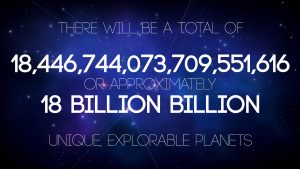No Man’s Sky is an ambitious game, and that ambition is seductive. It certainly seduced Sony, who after spotting the work in progress by the fairly small outfit Hello Games, began pushing it heavily and providing support in turning into a flagship product for the PlayStation 4 (Though it is on PC as well, and that is the version I played). After some modest delays, it has arrived. And, let’s get this out of the way without prevarication, it’s pretty bad.
The obvious comparison and one which has been made almost since NMS was first revealed is to Spore, perhaps the most legendary disappointment in gaming history. This isn’t an entirely fair comparison as, although things were cut and changed in the development of No Man’s Sky, most of those are reasonable things to change in the process of making a game. Not all, the absence of some features has caused much anger (Multiplayer is the big one), but a huge gulf between the game’s promised features and actual ones is not, unlike Spore or Fable, the wellspring of the game’s shortcomings.
The game’s premise is fairly simple: You’re a person with a spacesuit, a crashed spaceship, and a set of tools and blueprints. Using the things that work, you wander around a world to repair the things that don’t. Once completed you take off the same basic idea plays out, briefly in a solar system, then in the broader galaxy. This galaxy is, for reference, astonishingly vast, estimated to contain over 18 quintillion planets (that’s 18,000,000,000,000,000,000), which is not just vastly more than any player could explore, but more than the entire human population of seven or so billion could even make a single landing on, if we all worked together. Obviously this is more than could ever be made by hand, so Hello Games developed procedural generation algorithms to place stars and their systems, to create the landscape on these worlds, and to create flora and fauna to populate said worlds.

This is an impressive feat, make no mistake. That the game world is physically manifested, properly put together, and then populated, is remarkable. It should be stressed that the game’s shortcomings do not come from this side of things, despite the rash of issues players have been having, including me, and the rather poor level of graphical fidelity that is necessary to instantiate the huge worlds you land on. Bugs and graphics are mostly things that can and hopefully will be fixed with time and patching. No, the problems, sadly, stem from something rather deeper and more difficult to fix. Primarily, this might be the widest pool a game has ever presented us with, but it’s also a remarkably shallow one. The procedure throughout the game never really varies; you go to a planet, harvest resources with your laser mining gun thing, and spend those resources on refueling your ship and various tools, and on assembling upgrades you need. You do some poking around to find blueprints for more upgrades, but this is never more involved than either shooting down a Sentinel or poking your head into a tiny outpost and downloading them. Repeat this until you reach the center of the galaxy, however far away that may be. This is all done within the confines of an extremely annoying and restrictive inventory system.
This is all tedious. There is no other way to say it. Collecting resources is tedious. Refueling all your gear as well as your several distinct ship engines is tedious. Not getting the upgrades you want/need is tedious. Inventory management is horrible. An otherwise compelling experience might be able to overcome these issues but, alas, the game quickly proves itself to be tedious in the main as well as in the details. As part of the task of repairing my ship, I had to go find an element deposit to mine. It was about ten minute’s walk away, so I duly set off. Half an hour later I arrived – I had stopped to scan animals, harvest some resources, and had to navigate around a pretty awesome network of caves and sinkholes that ran throughout the landscape. It was genuinely cool and enjoyable. I got there, gathered the stuff, and headed back. And I pretty much walked in a straight line for the needed ten minutes as there was nothing else interesting do. But here’s the insidious problem that became apparent when I went to another planet to begin exploding: There was no new sense of wonder or desire to explore. It was exactly the same thing with a trivially different coat of paint. For example, I had originally thought it really cool and interesting that I found a type of plant from which I could harvest a small amount of platinum, but the new world contained an almost identical plant, just containing zinc instead. As I needed zinc, this was quite useful! And also demonstrative of the fact that for all the scope of the game there’s nothing unique about any of it.
The same pattern repeated itself. Things are visually different and that is all. There are occasional factors such as extreme temperatures or high amounts of radiation but these are just another annoying drain on your suit systems that you have to refuel. The animals have some visual variety, but that is it. None of them actually do anything interesting or unique. The plants, unsurprisingly, are even less interesting, being plants. Now, the planets and systems themselves fare a lot better in this regard. They do combine to create, at the least, unique vistas. It was unquestionably cool to be walking on a planet and seeing another one rising in the sky, knowing that I can hop in my ship and seamlessly fly over to it, land, and explore, with my current location hovering in the new sky. The flipside is that systems are so cramped with planets packed together – necessary for the ‘alien sky’ effect – that they feel downright claustrophobic.

But the presence of nice vistas isn’t nearly enough to salvage the game. I have no special insight into the thoughts of the developers, but seems to be thoroughly obvious that the development process was torn between making a game about pure exploration and one which incorporates more traditional gameplay elements. The end result feels like an ugly compromise, and the constant, irritating urging to locate the next mineral you need, to build the next ship part you need, to fabricate a fuel cell and jump to the next system all implies a developer who was not confident the exploration part of the game was enough to compel people by itself. They were right, as it turns out, but their solution only made it a weaker experience. A good game has elements which are in tension with each other and encourage the player to find the most efficient ways to overcome those tensions. This can be as simple as managing limited ammo in a shooter. No Man’s Sky demonstrates what happens when a developer tries and fails to implement such tensions. Everything simply gets in the way of everything else. You want to explore a planet, but you are regularly interrupted by warnings that your life support is draining. So you stop, blast apart some plants or rocks or crystals, replenish your life support, and carry on. You do it again a few minutes later. You want to explore space, but your fuel supplies need regular replenishment. You have to land on planets for at least some of those fuels, or you can sometimes buy them, but you usually make money best by landing and collecting stuff anyway. Again, it strongly suggests Hello Games had little confidence that people would explore the universe on its own merits, and they inserted a host of ‘reasons’ to do so – except those reasons only detract from the experience and make exploration a chore without enlivening it.
The same issue even appears in the way the game tells you you have completed an achievement. I know how trivial that sounds, but bear with me. When you complete an achievement, whether that is walking a certain distance, making your first planetfall, whatever, the game throws it up front and center. Big black bars appear to make it feel cinematic whilst the achievement name and what you did to get it take up much of the view. This isn’t necessarily a bad thing, as you’re unlikely to be in frantic action too often when this happens, but the game desperately wants to convince you that This Is Big, that You Did A Huge Thing, whereas actually I walked five kilometers and scanned an animal the size of a cat but weighing as much as an adult human.
No Man’s Sky deserves credit for the technical achievement it represents. Even with the problems of the PC port it is mind-boggling that such a game could exist at all. There are definitely worthwhile moments to be had, whether jetpacking over a series of sinkholes filled with glowing red plants and crystals, or seeing a unique continent formation on the face of a planet rising in the sky. But the awe wears off in a great hurry and you are left, beneath that veneer, with a game that is trivially shallow in every metric, which has a world for infinite exploration and nothing giving you an impetus to explore it, and gameplay mechanics that both fail to paper over that fact and which themselves are a paramount exercise in tedium and irritating busywork. It is possible that with content patches (or simply cheats that remove the resource side of things entirely) the game will become more than it is right now, but it is hard to recommend to anyone in its current state, and certainly not at the current price.
